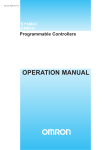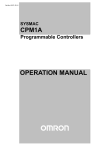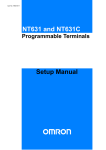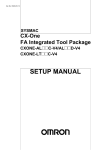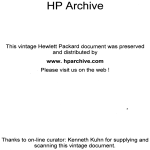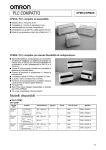Download Specifications
Transcript
Contents System Configuration . . . . . . . . . . . . . . . . . . . . . . . . . . . . . . . . 6 Specifications . . . . . . . . . . . . . . . . . . . . . . . . . . . . . . . . . . . . . . . 8 CPM1A Lineup . . . . . . . . . . . . . . . . . . . . . . . . . . . . . . . . . . . . . . . . . . . . . . . . CPM1A System Configuration . . . . . . . . . . . . . . . . . . . . . . . . . . . . . . . . . . . . External Dimensions . . . . . . . . . . . . . . . . . . . . . . . . . . . . . . . . . . . . . . . . . . . . General Specifications . . . . . . . . . . . . . . . . . . . . . . . . . . . . . . . . . . . . . . . . . . . Performance Specifications . . . . . . . . . . . . . . . . . . . . . . . . . . . . . . . . . . . . . . . I/O Specifications . . . . . . . . . . . . . . . . . . . . . . . . . . . . . . . . . . . . . . . . . . . . . . . Communications Adapter Specifications . . . . . . . . . . . . . . . . . . . . . . . . . . . . 6 7 7 8 9 10 13 Functions . . . . . . . . . . . . . . . . . . . . . . . . . . . . . . . . . . . . . . . . . . 14 Programming Instructions . . . . . . . . . . . . . . . . . . . . . . . . . . . Peripheral Devices . . . . . . . . . . . . . . . . . . . . . . . . . . . . . . . . . . Standard Models . . . . . . . . . . . . . . . . . . . . . . . . . . . . . . . . . . . . 20 24 25 Input Interrupts . . . . . . . . . . . . . . . . . . . . . . . . . . . . . . . . . . . . . . . . . . . . . . . . . Quickresponse Inputs . . . . . . . . . . . . . . . . . . . . . . . . . . . . . . . . . . . . . . . . . . . Highspeed Counter . . . . . . . . . . . . . . . . . . . . . . . . . . . . . . . . . . . . . . . . . . . . . Interval Timer Interrupts . . . . . . . . . . . . . . . . . . . . . . . . . . . . . . . . . . . . . . . . . Analog Setting . . . . . . . . . . . . . . . . . . . . . . . . . . . . . . . . . . . . . . . . . . . . . . . . . . Pulse Output Function . . . . . . . . . . . . . . . . . . . . . . . . . . . . . . . . . . . . . . . . . . . Communications . . . . . . . . . . . . . . . . . . . . . . . . . . . . . . . . . . . . . . . . . . . . . . . . 14 15 15 16 16 17 18 System Configuration CPM1A Line-up • DC input CPU with AC Power Supply 10 I/O points (Expansion not possible) 30 I/O points 20 I/O points (Expansion not possible) CPU with DC Power Supply 20 I/O points (Expansion not possible) 10 I/O points (Expansion not possible) • RY output • DC input 40 I/O points • RY output / TR output (Only DC power supply can be used with TR-output type.) 30 I/O points 40 I/O points Expansion I/O Unit Expansion I/O Unit CompoBus/S I/O Unit Analog I/O Unit • DC input • RY output / TR output • DC input • RY output / TR output CPM1A-SRT21 CPM1A-MAD01 20 I/O points RS-232C Adapter CPM1-CIF01 6 RS-422 Adapter CPM1-CIF11 System Configuration CPM1A System Configuration Peripheral port Connecting cable CPM1-CIF01/CIF11 Adapter Both AC and DC power supplies. 30-point CPU and 40-point CPU only. May be expanded up to a maximum of 3 Units. Expansion I/O Unit Expansion I/O Unit Expansion I/O Unit External Dimensions CPM1-CIF01 30 21 56 50 30 21 61 50 90 90 81 50 W DC power supply 85 AC power supply Unit: mm CPM1-CIF11 Model W (mm) CPM1A-10CDj-A/D 66 CPM1A-20CDj-A/D 86 CPM1A-30CDj-A/D 130 CPM1A-40CDj-A/D 150 CPM1A-20EDj 86 (depth: 50 mm) CPM1A-8Ej/SRT21 66 (depth: 50 mm) CPM1A-MAD01 66 (depth: 50 mm) 90 81 7 Specifications General Specifications Item Power supply y voltage/ g AC power supply f frequency DC power supply Operating g voltage g AC power supply range DC power supply Power consumption AC power supply DC power supply Inrush current External power supply Power supply ((AC only) y) voltage Power supply output capacity 10-point I/O 20-point I/O 100 to 240 VAC, 50/60 Hz 24 VDC 85 to 264 VAC 20.4 to 26.4 VDC 30 VAC max. 6 W max. 30 A max. 30-point I/O 40-point I/O 60 VAC max. 20 W max. 60 A max. 24 VDC 200 mA 300 mA Insulation resistance 20 MΩ min. at 500 VDC between the AC terminals and the protective earth terminal. Dielectric strength 2,300 VAC at 50/60 Hz for one minute with a leakage current of 10 mA max. between all the external AC terminals and the protective earth terminal. Noise resistance 1,500 V (peak to peak) with a pulse width of 0.1 to 1 µs, and 1-ns rise time pulse (tested with a noise simulator) Vibration resistance 10 to 57 Hz with an amplitude of 0.075 mm, and 57 to 150 Hz with an acceleration of 9.8 m/s2 in the X, Y, and Z directions for 80 minutes each (i.e. swept for 8 minutes, 10 times). Shock resistance 147 m/s2 in the X, Y and Z directions 3 times each. Ambient temperature (operating) 0° to 55°C Ambient humidity (operating) 10% to 90% (no condensation) Ambient environment (operating) With no corrosive gas Ambient temperature (storage) –20° to 75°C Terminal screw size M3 Power supply holding time 10 ms min. for AC models, and 2 ms min. for DC models Weight AC model: 400 g max. DC model: 300 g max. AC model: 500 g max. DC model: 400 g max. AC model: 600 g max. DC model: 500 g max. AC model: 700 g max. DC model: 600 g max. Note: 1. The specifications of the Expansion I/O Unit are the same as for the CPU except that the power is supplied from the CPU and the weight is 300 g. 2. TR output is only available to CPUs with DC power supply. 8 Specifications Performance Specifications Item 10-point I/O 20-point I/O 30-point I/O 40-point I/O Control method Stored program method I/O control method Combination of the cyclic scan and immediate refresh processing methods. Programming language Ladder diagram Instruction word Types y of Basic instructions i instructions i Special instructions 1 step per instruction, 1 to 5 words per instruction Instruction execution i time i 0.72 to 16.2 µs MOV instruction = 16.3 µs Basic instructions Special instructions Program capacity Maximum I/O CPU only points With Expansion I/O Unit 14 types 79 types, 139 instructions 2,048 words 10 points (6 input/ 4 output points) 20 points (12 input/ 8 output points) 30 points (18 input/ 12 output points) 40 points (24 input/ 16 output points) --- --- 90 points (54 input/ 36 output points) 100 points (60 input/ 40 output points) Input bits 00000 to 00915 (Words 0 to 9) Output bits 01000 to 01915 (Words 10 to 19) Work bits (IR Area) 512: IR 20000 to IR 23115 (IR 200 to IR 231) Special bits (SR Area) 384: SR 23200 to SR 25515 (SR 232 to SR 255) Temporary bits (TR Area) 8: TR 0 to TR 7 Holding bits (HR Area) 320: HR 0000 to HR 1915 (HR 00 to HR 19) Auxiliary bits (AR Area) 256: AR 0000 to AR 1515 (AR 00 to AR 15) Link bits (LR Area) 256: LR 0000 to LR 1515 (LR 00 to LR 15) Timers/Counters Data memory y Read/Write Read only Interrupt processing: External interrupt 128: TIM/CNT 000 to 127 100-ms timer: TIM 000 to TIM 127 10-ms timer: TIM 000 to TIM 127 Decremental counter, reversible counter 1,024 words (DM 0000 to DM 1023) 512 words (DM 6144 to DM 6655) 2 points (Response 4 points (Response time of 0.3 ms max.) time of 0.3 ms max.) Memory protection Maintains the contents of the HR, AR, Counter and Data Memory Areas. Memory backup Flash memory: Self-diagnostic function User program, data memory (Read only) (Non-battery powered storage) Super capacitor: Data memory (Read/Write), holding bits, auxiliary memory bits, counter (20-day storage at an ambient temperature of 25°C) CPU error (watchdog timer), memory errors, I/O bus errors Program check No END instruction programming errors (constantly checked during operation) Pulse output 1 point: 2 kHz High-speed counter 1 point: Single phase at 5 kHz or two-phase at 2.5 kHz (linear counting method) Incremental mode: 0 to 65535 (16-bit) Decremental mode:–32767 to 32767 (16-bit) 1 point: Single phase at 5 kHz or two-phase at 2.5 kHz (linear counting method) Incremental mode: 0 to 65535 (16-bit) Decremental mode:–32767 to 32767 (16-bit) Quick-response inputs Together with the external interrupt input (minimum pulse width of 0.2 ms) Input time constant Can be set at 1 ms, 2 ms, 4 ms, 8 ms, 16 ms, 32 ms, 64 ms, or 128 ms. Analog settings 2 points: (0 to 200) Note: Bits that are not used for the I/O bits can be used as work bits. 9 Specifications I/O Specifications Input Circuit CPU Item Specifications Input voltage Input impedance 24 VDC +10%/–15% IN0000 to IN0002: 2 kΩ Others: 4.7 kΩ Input current (typical) IN0000 to IN0002: 12 mA Others: 5 mA ON voltage OFF voltage ON delay (see note 1) OFF delay (see note 1) 14.4 VDC min. 5.0 VDC max. 1 to 128 ms max. (default: 8 ms) (see note 1) 1 to 128 ms max. (default: 8 ms) (see note 1) Circuit Input LED 4.7 kΩ IN Internal Circuits 4.7 kΩ COM Note The polarity y of the input power supply y can be either positive iti or negative. ti Note: 1. The actual ON/OFF delay includes an input constant of 1, 2, 4, 8, 16, 32, 64, or 128 ms (default: 8 ms). 2. The delays for IN0000 to IN0002 are as follows when used for the high-speed counter. Input IN0000 (A-phase) IN0001 (B-phase) IN0002 (Z-phase) Increment mode Differential phase mode 2.5 kHz 5 kHz Normal input ON: 100 µs max. OFF: 500 µs max. 3. The delays for IN0003 to IN0006 are as follows when used for the high-speed counter. Delay 0.3 ms max. (From the time of input ON until the interrupt subroutine is executed.) Expansion I/O Unit Item Specifications Circuit +10%/ –15% Input voltage Input impedance Input current (typical) ON voltage OFF voltage ON delay 24 VDC, 4.7 kΩ 5 mA 14.4 VDC min. 5.0 VDC max. 1 to 128 ms max. (default: 8 ms) (see note) OFF delay 1 to 128 ms max. (default: 8 ms) (see note) Input LED 4.7 kΩ IN COM 4.7 kΩ Internal Circuits Note The polarity of the input power supply can be either positive or negative. Note: The actual ON/OFF delay includes an input constant of 1, 2, 4, 8, 16, 32, 64, or 128 ms (default: 8 ms). 10 Specifications Output Circuit CPU and Expansion I/O Unit Relay Output Specifications Item Maximum switching capacity 250 VAC/2 A (cos φ =1) 24 VDC/2 A (4 A/common) Minimum switching capacity Relay Electrical Resisservice tance life load 5 VDC, 10 mA 300,000 times OUT Output LED Internal Circuits OUT COM Inductive load Mechanical ON delay OFF delay Circuit 100,000 times Maximum 250 VAC: 2 A 24 VDC: 2 A 10 million times 15 ms max. 15 ms max. Transistor Output (Sink Type/Source Type) (CPU/Expansion I/O Unit) Item Specifications Maximum switching capacity +10%/ –15%, 24 VDC (see note 1) Leakage current 0.1 mA max. Residual voltage 1.5 V max. Circuit 300 mA Sink Type Output LED Internal Circuits OUT OUT 24 VDC COM ((–)) Source Type Output LED ON delay 0.1 ms max. COM (+) Internal Circuits OFF delay OUT 24 VDC 1 ms max. (see note 2) OUT Note: 1. The maximum switching capacity of the CPM1A with transistor outputs (sink type and source type) are limited to the currents shown in the following table for the common and for the Unit. Item Max. switching capacity 10CDT/ 10CDT1-D 0.9 A/Unit 20CDT-D/ 20CDT1-D 0.9 A/common 1.8 A/Unit 30CDT-D/ 30CDT1-D 0.9 A/common 2.7 A/Unit 40CDT-D/ 40CDT1-D 0.9 A/common 3.6 A/Unit 20EDT/ 20EDT1 CPM1A-8ET/ 8ET1 0.9 A/common 1.8 A/Unit 2. When using the pulse output function of the CPM1A with transistor outputs (sink type and source type): The output current must be within a range from 100 to 200 mA when using the output 01000 or 01001 as a pulse output with the maximum frequency of 2 kHz. The outputs 01000 and 01001 will vary depending on the output current. Load current OFF delay 100 to 200 mA 0.2 ms max. 0 to 300 mA except for the above range 0.5 ms max. 11 Specifications Analog I/O Unit Item Analog g i inputs Analog g output (See note 1.) Voltage I/O Number of inputs Input signal range Maximum rated input External input impedance Resolution Overall precision Converted A/D data Number of outputs Output signal range External output max. current External output allowed load resistance 2 0 to 10 V or 1 to 5 V ±15 V 1 MΩ min. 1/256 1.0% of full scale 8-bit binary 1 0 to 10 V or –10 to 10 V 5 mA --- Current I/O 4 to 20 mA ±30 mA 250 Ω rated 4 to 20 mA --350 Ω Resolution Overall precision Data setting Conversion time (See note 2.) 1/256 (1/512 when the output signal range is –10 to 10 V.) 1.0% of full scale 8-bit binary with sign bit 10 ms/Unit max. Isolation method Photocoupler isolation between I/O terminals and PC (There is no isolation between the analog I/O signals.) Note 1. The voltage output and current output can be used at the same time, but the total output current cannot exceed 21 mA. 2. The conversion time is the total time for 2 analog inputs and 1 analog output. CompoBus/S I/O Link Unit Specifications Item Specification Model number CPM1A-SRT21 Master/Slave CompoBus/S Slave Number of I/O bits 8 input bits, 8 output bits Number of words occupied in CPM1A I/O memory 1 input word, 1 output word Node number setting Set using the DIP switch. (Allocated in the same way as other Expansion Units) Note: See the CompoBus/S Catalog (Q103) for more details on CompoBus/S communications. 12 Specifications Communications Adapter Specifications RS-232C Adapter and RS-422 Adapter Specifications Item CPM1-CIF01 Level conversion between the CMOS level (CPU side) and the RS-232C (peripheral device side) CPM1-CIF11 Level conversion between the CMOS level (CPU side) and the RS-422 (peripheral device side) Insulation The RS-232C (peripheral device side) is insulated by a DC/DC converter and photocoupler. The RS-422 (peripheral device side) is insulated by a DC/DC converter and photocoupler. Power supply Power is supplied by the CPU. Power consumption 0.3 A max. Transmission speed 38.4 Kbits/s max. Vibration resistance 10 to 57 Hz with an amplitude of 0.075 mm, and 57 to 150 Hz with an acceleration of 9.8 m/s2 in the X, Y and Z directions for 80 minutes each in accordance (i.e. swept for 8 minutes, 10 times). Shock resistance 147 m/s2 in the X, Y and Z directions 3 times each. Ambient temperature (operating) 0° to 55°C Ambient humidity (operating) 10% to 90% (with no condensation) Ambient environment (operating) With no corrosive gas Ambient temperature (storage) –20° to 75°C Weight 200 g max. Functions Memory Backup The user program and memory area data in the CPU Unit are backed up by either one of the following methods. The capacitor provides backup for a power interruption lasting 20 days at room temperature. If the power is expected to remain OFF for a period exceeding this data backup period, consideration must be given to the design of the system so that no problems will occur when the set values become undefined ones. For further details, refer to CPM1A Operation Manual (W317). Capacitor backup time (days) • Flash Memory: User program, read-only DM area (DM 6144 to DM 6599), and PC Setup area (DM 6600 to DM 6655). • Internal Capacitor: DM areas other than the above, HR area, AR area, and Counter area. 20 10 7 1 25 40 80 Ambient temperature (_C) 13 Functions Input Interrupts There are two input interrupts in the CPM1A 10-point I/O CPU and four in the 20-, 30-, and 40-point I/O CPUs. Input interrupts are available in two modes. Application Example: 10-point I/O CPU 20-, 30-, and 40-point I/O CPU Cutting Metal Sheets to Specified Lengths The proximity sensor detects the edge of a metal plate to operate the cutter. Metal sheets can be cut continuously to the specified lengths at a high speed. Metal sheets Cutter Conveyor Proximity sensor Input interrupt Cutter operation signal CPM1A Input Interrupt Mode If an input interrupt occurs, the regular program shuts down irrelevant of the cycle time, and the interrupt processing program is executed immediately. Regular program Regular program Interrupt program Input interrupt Counter Mode When the number of external signals counted at high speed reaches a specified number of counts, the regular program shuts down, and the interrupt processing program is executed at fixed counts. The count can be set between 0 and 65535. Regular program Regular program Interrupt program Input interrupt Counter setting 14 Functions Quick-response Inputs There are two quick-response inputs for the CPM1A 10-point I/O CPU and four for the 20-, 30-, and 40-point I/O CPU (shared with the interrupt inputs). Since an internal buffer is provided, the quick-response input function can even detect signals modified within one cycle. CPU Input no. 10-point I/O CPU 20-point, 30-point, 40-point I/O CPU Minimum input pulse width 0.2 ms 00003 to 00004 00003 to 00006 Application Example: Overseeing processes Program execution I/O refreshing Overseeing Program processes execution Calculating the Number of Chips I/O refreshing The metal sensor counts the number of parts that have passed. Steady counting can be achieved even when the input-ON time is short. 0.2 ms min Input signal (00003) CPM1A IR 00003 One cycle F2LP-WK4 F2LP-W High-speed Counter The CPM1A has a high-speed counter function that can be used in the incrementing and up/down mode. Using this function together with the input interrupts enables zone comparison control or target value control irrelevant of the cycle time. Incrementing mode Item Input no. 00000 00001 00002 Up/Down mode Input method Count input --Reset input Single-phase input A-phase input B-phase input Z-phase input Phase-difference, 4× inputs Count frequency 5.0 kHz 2.5 kHz Count range 0 to 65535 –32767 to 32767 Note: When using in the incrementing mode, the input 00001 can be used as an input contact. Count input 00000 00001 00002 Reset input Solenoid Sensor Rotary encoder Inverter, etc. 15 Functions Interval Timer Interrupts The CPM1A has one interval timer. The interval timer shuts down the regular program irrelevant of the point in the cycle once the time is up, and immediately executes an interrupt processing program. Interval timers are used in the following two modes. One-shot mode Item Scheduled interrupt mode Operation An interrupt is executed only once when the time is up. Interrupts are executed repeatedly at fixed periods. Setting time 0.5 ms to 319,968 ms (0.1-ms units) Application Example: Normal program Computing the Sheet Speed The number of pulse inputs is computed in the interrupt mode at a fixed time to calculate the speed. Interval timer MOV(21) ADD(30) CPM1A Interrupt processing program Encoder SBN(92) 00 MOV(21) RET(93) END(01) Analog Setting The CPM1A contains two analog setting controls that can be used for a broad range of analog timer and counter settings. Turning the setting control stores values of 0 to 200 (BCD data) in the SR area. Analog setting Analog setting 0 Analog setting 1 Analog setting 0 Analog setting 1 *Phillips screwdriver is required. Storage area Setting value (BCD) 0000 to 0200 SR 250 SR 251 Application Example: Tact Operation Control of Conveyor Lines A conveyor can be stopped temporarily as required for assembly processes. When the timer function and limit switches are used in a combination, conveyors can be stopped for a fixed time or can be run at a constant speed for a fixed distance. Fine adjustment of the stopping time can be easily done by using the analog setting controls. CPM1A LS Motor 16 Functions Program Example 1. Analog timer for 0.0 to 20.0 seconds 2. A Analog timer for 0.0 to 60.0 seconds 25313(ON) TIM 000 250 BCD multiplication MUL(32) Value of the analog setting 0 (0 to 200) Triples the above value 250 #0003 DM0500 Value of the analog setting 0 (0 to 200) Multiplication result (0 to 600) B TIM 001 DM 0500 Pulse Output Function The CPM1A with transistor output has a function that is capable of outputting a pulse of up to 2 kHz. Program Example 1 scan turns ON. When used in combination with a Stepping Driver or Servodriver, positioning can be easily performed. 25315 MOV(21) #5000 DM 0000 Application Example MOV(21) #0002 DM 0001 Changing the speed of the Stepping Motor. Sets the number of output pulses as 25,000 (times) in the data memory area. DM 0001 0 0 0 DM 0000 2 5 0 MOV(21) #0200 DM 0100 Sets the initial frequency to 2,000 pulses/second. PULS(65) 000 000 DM 0000 Pulse rate setting 0 0 25315 Output point 01000 or 01001 1 scan turns ON. 00200 15000 Stepping Motor Driver Speed change limit switch 00001 MOV(21) #0020 DM 0100 Stepping Motor ÉÉÉÉÉ ÉÉÉÉÉ ÉÉÉÉÉ ÉÉÉÉÉ ÉÉÉÉÉ @SPED(64) 000 000 DM 0100 Pulse rate (BCD 8 digits) Frequency conversion: Output port (output point 01000) Output mode (single) Frequency data (x 10 Hz) Changes to 200 Hz when the limit switch is turned ON. 25,000 pulses Output 1 kHZ frequency 200 Hz 00000 turns ON 15000 Pulse rate 0001 turns ON (limit switch) 17 Functions Communications Host Link Communications CPM1A host link communications consist of interactive procedures whereby the CPM1A returns a response to a command sent from the IBM PC/AT or compatible computer. These communications allow the IBM PC/AT or compatible computer to read and write in the CPM1A’s I/O Areas and Data Memory Areas as well as in areas containing the status of various settings. Response Command 1:1 Host Link Communications RS-232C Adapter CPM1A CPU Response Link Adapter 3G2A9-AL004-E Command 1:n Host Link Communications RS-422 Adapter 18 CPM1A CPU RS-422 Adapter CPM1A CPU RS-422 Adapter CPM1A CPU Functions 1:1 Links With a 1:1 link, two CPM1As or a CPM1A and CQM1 or C200Hj are connected 1:1 with one side as the Master and the other as the Slave to provide an I/O link of a maximum of 256 points (LR 0000 to LR 1515). Example of a 1:1 Link between CPM1As RS-232C Cable RS-232C Adapter RS-232C Adapter CPM1A CPU CPM1A CPU Master Slave Link bits Link bits LR 00 WRITE LR 00 WRITE area READ area LR 07 LR 08 LR 07 LR 08 READ area READ READ WRITE area LR 15 WRITE LR 15 Limitations of the CPM1A 1:1 Link CPM1A I/O links are limited to 16 words (LR 00 to LR 15). Therefore, use these 16 words (LR 00 to LR 15) on the CQM1 or C200Hj side when forming 1:1 links with a CQM1 or C200Hj. NT Links High-speed communications can be achieved by providing a direct access through the use of the NT Link between the CPM1A and Programmable Terminal. Programmable Terminal RS-232C Adapter RS-232C Cable CPM1A CPU 19 Programming Instructions Summary of Programming Instructions Sequence Output Instructions Function Code Chart Table symbols f Code Details Key operations for specifying programming instructions Allocated to instruction keys on the Programming Console. These need not be specified with function codes. Special instructions specified with function codes. --- Code FUN WRITE Differentiated Instructions Differentiated instructions can sometimes be used for CPM1A special instructions. Instructions marked with (@) in the mnemonics can also be used as differentiated instructions. Here the input rise time (shift from OFF to ON) is used to execute the instruction in just one cycle. To specify an instruction, press the NOT Key after the function code. Example: Specifying the @MOV (21) instruction FUN 2 1 NOT WRITE Instruction Mnemonic Code OUTPUT OUT f Outputs the result of logic to a bit. OUT NOT OUT NOT f Reverses and outputs the result of logic to a bit. SET SET f Force sets (ON) a bit. RESET RSET f Force resets (OFF) a bit. KEEP KEEP 11 Maintains the status of the designated bit. DIFFERENTIATE UP DIFU 13 Turns ON a bit for one cycle when the execution condition goes from OFF to ON. DIFFERENTIATE DOWN DIFD 14 Turns ON a bit for one cycle when the execution condition goes from ON to OFF. Note: f: Instruction keys allocated to the Programming Console. Sequence Control Instructions Instruction Mnemonic Code NO OPERATION NOP 00 --- END END 01 Required at the end of the program. INTERLOCK IL 02 If the execution condition for IL(02) is OFF, all outputs are turned OFF and all timer PVs reset between IL(02) and the next ILC(03). INTERLOCK CLEAR ILC 03 ILC(03) indicates the end of an interlock (beginning at IL(02)). JUMP JMP 04 If the execution condition for JMP(04) is ON, all instructions between JMP(04) and JME(05) are treated as NOP(00). JUMP END JME 05 JME(05) indicates the end of a jump (beginning at JMP(04)). Sequence Instructions Sequence Input Instructions Function Function Function Instruction Mnemonic Code LOAD LD f Connects an NO condition to the left bus bar. LOAD NOT LD NOT f Connects an NC condition to the left bus bar. AND AND f Connects an NO condition in series with the previous condition. AND NOT AND NOT f Connects an NC condition in series with the previous condition. OR OR f Connects an NO condition in parallel with the previous condition. OR NOT OR NOT f Connects an NC condition in parallel with the previous condition. Instruction Mnemonic Code TIMER TIM f An ON-delay (decrementing) timer. COUNTER CNT f A decrementing counter. REVERSIBLE COUNTER CNTR 12 Increases or decreases PV by one. HIGHSPEED TIMER TIMH 15 A high-speed, ON-delay (decrementing) timer. AND LOAD AND LD f Connects two instruction blocks in series. OR LOAD OR LD f Connects two instruction blocks in parallel. Note: f: Instruction keys allocated to the Programming Console. Timer/Counter Instructions Function Note: f: Instruction keys allocated to the Programming Console. 20 Programming Instructions Step Instructions Instruction Mnemonic Code STEP DEFINE STEP 08 STEP START SNXT 09 Data Conversion Instructions Function Defines the start of a new step and resets the previous step when used with a control bit. Defines the end of step execution when used without a control bit. Starts the execution of the step when used with a control bit. Increment/Decrement Instructions Instruction Mnemonic Code INCREMENT (@)INC 38 Increments the BCD content of the specified word by 1. DECREMENT (@)DEC 39 Decrements the BCD content of the specified word by 1. Instruction Mnemonic Code BCD TO BINARY (@)BIN 23 Converts 4-digit BCD data to 4-digit binary data. BINARY TO BCD (@)BCD 24 Converts 4-digit binary data to 4-digit BCD data. 4 TO 16 DECODER (@)MLPX 76 Takes the hexadecimal value of the specified digit(s) in a word and turns ON the corresponding bit in a word(s). 16 TO 4 DECODER (@)DMPX 77 Identifies the highest ON bit in the specified word(s) and moves the hexadecimal value(s) corresponding to its location to the specified digit(s) in a word. ASCII CODE CONVERT (@)ASC 86 Converts the designated digit(s) of a word into the equivalent 8-bit ASCII code. Function BCD/Binary Calculation Instructions Instruction Mnemonic Code Function BCD ADD (@)ADD 30 Adds the content of a word (or a constant). BCD SUBTRACT (@)SUB 31 Subtracts the content of a word (or constant) and CY from the content of a word (or constant). BCD MULTIPLY (@)MUL 32 Multiplies the contents of two words (or constants). BCD DIVIDE (@)DIV 33 Divides the content of a word (or constant) by the content of a word (or constant). BINARY ADD (@)ADB 50 Adds the contents of two words (or constants) and CY. BINARY SUBTRACT (@)SBB 51 Subtracts the content of a word (or constant) and CY from the content of a word (or constant). BINARY MULTIPLY (@)MLB 52 Multiplies the contents of two words (or constants). BINARY DIVIDE (@)DVB 53 Divides the content of a word (or constant) by the content of a word and obtains the result and remainder. DOUBLE BCD ADD (@)ADDL 54 Add the 8-digit BCD contents of two pairs of words (or constants) and CY. DOUBLE BCD SUBTRACT (@)SUBL 55 Subtracts the 8-digit BCD contents of a pair of words (or constants) and CY from the 8-digit BCD contents of a pair of words (or constants). DOUBLE BCD MULTIPLY (@)MULL 56 Multiplies the 8-digit BCD contents of two pairs of words (or constants). DOUBLE BCD DIVIDE (@)DIVL 57 Divides the 8-digit BCD contents of a pair of words (or constants) by the 8-digit BCD contents of a pair of words (or constants). Function Data Comparison Instructions Instruction Mnemonic Code COMPARE CMP 20 Compares two four-digit hexadecimal values. Function DOUBLE COMPARE CMPL 60 Compares two eight-digit hexadecimal values. BLOCK COMPARE (@)BCMP 68 Judges whether the value of a word is within 16 ranges (defined by lower and upper limits). TABLE COMPARE (@)TCMP 85 Compares the value of a word to 16 consecutive words. 21 Programming Instructions Data Movement Instructions Shift Instructions Instruction Mnemonic Code MOVE (@)MOV 21 Copies a constant or the content of a word to a word. MOVE NOT (@)MVN 22 Copies the complement of a constant or the content of a word to a word. Mnemonic Code Function SFT f/10 Copies the specified bit (0 or 1) into the rightmost bit of a shift register and shifts the other bits one bit to the left. WORD SHIFT (@)WSFT 16 Creates a multiple-word shift register that shifts data to the left in one-word units. ASYNCHRONOUS SHIFT REGISTER (@)ASFT 17 Creates a shift register that exchanges the contents of adjacent words when one is zero and the other is not. ARITHMETIC SHIFT LEFT (@)ASL 25 Shifts a 0 into bit 00 of the specified word and shifts the other bits one bit to the left. (@)XFER BLOCK SET (@)BSET 71 Copies the content of a word to a block of consecutive words. DATA EXCHANGE (@)XCHG 73 Exchanges the content of two words. SINGLE WORD DISTRIBUTE (@)DIST 80 Copies the content of a word to a word (whose address is determined by adding an offset to a word address). ARITHMETIC SHIFT RIGHT (@)ASR 26 Shifts a 0 into bit 15 of the specified word and shifts the other bits one bit to the right. DATA COLLECT (@)COLL 81 Copies the content of a word (whose address is determined by adding an offset to a word address) to a word. ROTATE LEFT (@)ROL 27 MOVE BIT (@)MOVB 82 Copies the specified bit from one word to the specified bit of a word. Moves the content of CY into bit 00 of the specified word, shifts the other bits one bit to the left, and moves bit 15 to CY. ROTATE RIGHT (@)ROR 28 Moves the content of CY into bit 15 of the specified word, shifts the other bits one bit to the right, and moves bit 00 to CY. ONE DIGIT SHIFT LEFT (@)SLD 74 Shifts a 0 into the rightmost digit (4-bit unit) of the shift register and shifts the other digits one digit to the left. ONE DIGIT SHIFT RIGHT (@)SRD 75 Shifts a 0 into the leftmost digit (4-bit unit) of the shift register and shifts the other digits one digit to the right. REVERSIBLE SHIFT REGISTER (@)SFTR 84 Creates a single or multipleword shift register that can shift data to the left or right. (@)MOVD 83 Copies the content of a block of up to 1,000 consecutive words to a block of consecutive words. Instruction SHIFT REGISTER BLOCK TRANSFER MOVE DIGIT 70 Function Copies the specified digits (4-bit units) from a word to the specified digits of a word. Logic Instructions Instruction Mnemonic Code COMPLEMENT (@)COM 29 Turns OFF all ON bits and turns ON all OFF bits in the specified word. LOGICAL AND (@)ANDW 34 Logically ANDs the corresponding bits of two words (or constants). LOGICAL OR (@)ORW 35 Logically ORs the corresponding bits of two words (or constants). EXCLUSIVE OR (@)XORW 36 Exclusively ORs the corresponding bits of two words (or constants). EXCLUSIVE NOR (@)XNRW 37 Exclusively NORs the corresponding bits of two words (or constants). 22 Function Note: f: Instruction keys allocated to the Programming Console. Special Calculation Instruction Instruction Mnemonic Code BIT COUNTER (@)BCNT 67 Function Counts the total number of bits that are ON in the specified block of words. Programming Instructions Pulse Output Control Instructions Subroutine Instructions Instruction Mnemonic Code Function SUBROUTINE ENTER (@)SBS 91 Executes a subroutine in the main program. SUBROUTINE ENTRY SBN 92 Marks the beginning of a subroutine program. SUBROUTINE RETURN RET 93 Marks the end of a subroutine program. MACRO MCRO 99 Calls and executes the specified subroutine, substituting the specified input and output words for the input and output words in the subroutine. Interrupt Control Instructions Instruction Mnemonic Code INTERVAL TIMER (@)STIM 69 Controls interval timers used to perform scheduled interrupts. Function INTERRUPT CONTROL (@)INT 89 Performs interrupt control, such as masking and unmasking the interrupt bits for I/O interrupts. Peripheral Device Control Instructions I/O Unit Instructions Instruction Mnemonic Code 7-SEGMENT DECODER (@)SDEC 78 Converts the designated digit(s) of a word into an 8-bit, 7-segment display code. I/O REFRESH (@)IORF 97 Refreshes the specified I/O word. Instruction Mnemonic Code Function SPEED OUTPUT (@)SPED 64 Outputs pulses at the specified frequency. The output frequency can be changed while the pulses are being output. SET PULSES (@)PULS 65 Outputs the specified number of pulses at the specified frequency. The pulse output cannot be stopped until the specified number of pulses have been output. Damage Diagnosis Instructions Instruction Mnemonic Code Function FAILURE ALARM (@)FAL 06 Generates a non-fatal error when executed. The Error/ Alarm indicator flashes and the CPU continues operating. SEVERE FAILURE ALARM FALS 07 Generates a fatal error when executed. The Error/Alarm indicator lights and the CPU stops operating. Special System Instructions Instruction Mnemonic Code SET CARRY (@)STC 40 Sets Carry Flag 25504 to 1. Function CLEAR CARRY (@)CLC 41 Sets Carry Flag 25504 to 0. Function Display Instruction Instruction Mnemonic Code MESSAGE (@)MSG 46 Function Reads up to 8 words of ASCII code (16 characters) from memory and displays the message on the Programming Console or other Peripheral Device. High-speed Counter Control Instructions Instruction Mnemonic Code MODE CONTROL (@)INI 61 Starts and stops counter operation, compares and changes counter PVs, and stops pulse output. Function PV READ (@)PRV 62 Reads counter PVs and status data. COMPARE TABLE LOAD (@)CTBL 63 Compares counter PVs and generates a direct table or starts operation. 23 Peripheral Devices SYSMAC-CPT: WS01-CPTB1-E (for Windows 3.1 or 95) IBM PC/AT or compatible CPM1A CPU SYSMAC Support Software: C500-ZL3AT1-E (for MS-DOS) ÇÇÇÇ ÇÇÇÇ Peripheral Device Connecting Cable CQM1-CIF02 Programming Console Connecting Cable Programming Console Programming Console (With Connecting Cable) ÇÇ ÇÇ C200H-CN222/CN422 (2 m/4 m) C200H-PRO27-E 24 CQM1-PRO01-E Standard Models CPU Name 10-point I/O Power supply Output method AC power supply DC power supply y Relay output Relay output Transistor output (sink type) Input points 6 points Output points 4 points Transistor output (source type) 20-point I/O AC power supply DC power supply y Relay output Relay output Transistor output (sink type) AC power supply DC power supply y Relay output Relay output Transistor output (sink type) 12 points 8 points AC power supply DC power supply y Relay output Relay output Transistor output (sink type) U,, C,, N,, L U, C, CE CPM1A-20CDR-A CPM1A-20CDR-D CPM1A-20CDT-D U,, C,, N,, L U, C, CE CPM1A-20CDT1-D 18 points 12 points Transistor output (source type) 40-point I/O CPM1A-10CDR-A CPM1A-10CDR-D CPM1A-10CDT-D Standards CPM1A-10CDT1-D Transistor output (source type) 30-point I/O Model CPM1A-30CDR-A CPM1A-30CDR-D CPM1A-30CDT-D U,, C,, N,, L U, C, CE CPM1A-30CDT1-D 24 points 16 points Transistor output (source type) CPM1A-40CDR-A CPM1A-40CDR-D CPM1A-40CDT-D U,, C,, N,, L U, C, CE CPM1A-40CDT1-D Expansion I/O Unit Expansion Unit Max. number of Units Expansion I/O 3 Units U i Units max. (See note.) Analog I/O Unit CompoBus/S I/O Link Unit 3 Units max. (See note.) 3 Units max. (See note.) Output type Inputs Outputs Model Standards Relay Transistor (sinking) Transistor (sourcing) --- 12 8 8 --- CPM1A-20EDR1 U, C, CE CPM1A-20EDT U, C, CE CPM1A-20EDT1 U, C, CE U, C, CE CPM1A-8ED Relay --- 8 CPM1A-8ER U, C, CE Transistor (sinking) Transistor (sourcing) Analog --- 8 CPM1A-8ET CPM1A-8ET1 U,, C,, CE 2 1 U, C, CE CPM1A-MAD01 --- I/O Link of 8 input bits and 8 output bits U, C, CE CPM1A-SRT21 Note: Only one Expansion Unit can be connected if an NT-AL001 Adapter is connected to the CPU Unit’s RS-232C port. • U: UL, C: CSA, N: NK, L: Lloyd, CE: EC Directives Please contact OMRON representative for application conditions. 25 Standard Models RS-232C Adapter, RS-422 Adapter, Connecting Cable, Link Adapter Name Function Converts peripheral port levels. RS-232C Adapter RS-422 Adapter Model Standards U, C, N, L, CE CPM1-CIF01 CPM1-CIF11 Connecting Cable 3.3-m cable used to connect IBM PC/AT or compatible personal computers. CQM1-CIF02 U, C, N, L, CE Link Adapter Converts RS-232C and RS-422 levels. 3G2A9-AL004-E --- Programming Console Name Programming g g Console Model Standards With a 2-m cable --2-m Connecting Cable for C200H-PRO27-E Function CQM1-PRO01-E C200H-PRO27-E C200H-CN222 U, C, N, CE U, C, CE --- 4-m Connecting Cable for C200H-PRO27-E C200H-CN422 --- Programming Software Name Operating system Operating environment Model SYSMAC-CPT Windows 3.1 or 95 Used in IBM PC/AT or compatible personal computers (i486DX/Pentium) WS01-CPTB1-E SYSMAC Support Software MS-DOS Ver. 5.0 or later Used in IBM PC/AT or compatible personal computers (i386/i486/Pentium) C500-ZL3AT1-E 26 • U: UL, C: CSA, N: NK, L: Lloyd, CE: EC Directives Please contact OMRON representative for application conditions. OMRON Corporation Systems Components Division 66 Matsumoto Mishima-city, Shizuoka 411-8511 Japan Tel: (81)559-77-9633/Fax: (81)559-77-9097 Regional Headquarters OMRON EUROPE B.V. Wegalaan 67-69, NL-2132 JD Hoofddorp The Netherlands Tel: (31)2356-81-300/Fax: (31)2356-81-388 OMRON ELECTRONICS, INC. 1 East Commerce Drive, Schaumburg, IL 60173 U.S.A. Tel: (1)847-843-7900/Fax: (1)847-843-8568 OMRON ASIA PACIFIC PTE. LTD. 83 Clemenceau Avenue, #11-01, UE Square, Singapore 239920 Tel: (65)835-3011/Fax: (65)835-2711 Authorized Distributor: Cat. No. P039-E1-4 Note: Specifications subject to change without notice. Printed in Japan 0699-3.5M























